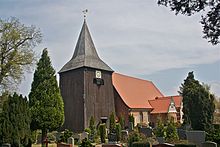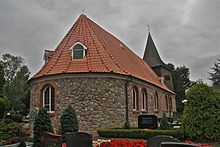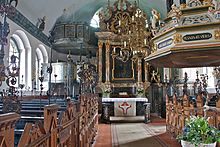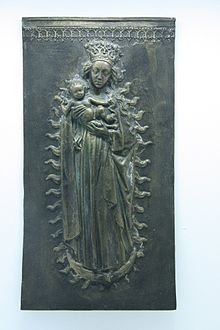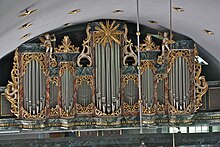St. Nicolai (Hamburg-Altengamme)
St. Nicolai zu Hamburg-Altengamme is one of the eight Hamburg country churches and is considered the oldest of the village churches in the Vier- und Marschlande area . It is dedicated to St. Nicholas of Myra , the patron saint of children, fishermen, sailors and traders. Since the Reformation, which took effect in Altengamme around 1535, it has been the center of an Evangelical Lutheran congregation.
Building the church
Even if the church was first mentioned in a document in 1247, its foundations, which are still preserved today, were apparently laid more than 100 years earlier, during the first settlement period of the Vierlande in the first half of the 12th century. On top of them rested a fortification made of field stone walls, which can still be seen between the chancel and today 's women's bridal house . Around 1605 the wooden tower was built next to the church; At that time, as is customary in the area, it had no direct connection to the main building.
After the church collapsed in a storm in 1747, it was rebuilt from 1748 to 1752. This new structure still determines the appearance of the church as a hall church with a semicircular choir . The eastern porch was built in 1837, the western porch as part of a very extensive repair in 1907 and 1908 by Julius Faulwasser with advice from Justus Brinckmann . The last important repair work took place between 1950 and 1954 and removed damage caused by moisture in the masonry and foundation.
Furnishing
The higher of the two extensions is known as the men's bridal house; the inside is decorated with a peasant painting. The smaller extension is unadorned on the inside and is called the women's bridal house. These two additions form the main entrances to the church.
The current Baroque interior of the main room of the church dates from the late 16th century , for which it is widely known in the area. The two galleries to the left and right of the altar and the so-called “women's gallery” under the organ fill and complement the room, but are also unusually arranged on the transverse sides of the room. The wooden barrel ceiling is painted blue and decorated with irregularly arranged golden stars. The high altar is dominated by two paintings with Easter scenes, the crucifixion and the last supper .
The bronze baptismal font (also called Fünte in Northern Germany , Low German Döpe or Dööp ) from 1380 with its lowerable baptismal lid from around 1610, which was originally made on the Lower Rhine, deserves special attention . In 1924 Ernst Kahlbrand added a lid and a brass baptismal jug . Very conspicuous and unusual outside of Vierlande are the 55 richly decorated and individually made hat stands that are mounted on the men's benches and date from 1708 to 1800. The stalls have many valuable inlaid work made by local craftsmen. The four chandeliers in the interior were made in 1640 and 1719.
Next to the altar is a well-preserved confessional from 1784. The fact that a confessional was set up in a Protestant church more than 240 years after the Reformation shows how slowly the meaning and implementation of confession have changed. The confessional is now used as a sacristy .
The church continues to decorate the church today: for example, the embroidered seat cushions on the pews are handicrafts created by the women of the church in 1975, and a large decorative Bible, created jointly by the congregation, has been part of the church furnishings since 2000 .
Bells
The bell of the church consists of three bells with the approximate strike tone sequence d'-f'-a '. The largest bell, 1.40 m high and weighing 36 hundred pounds , is called "Celsa" according to its inscription. It was originally the fourth largest bell in Hamburg's Mariendom and was also known there as the “four o'clock bell”. It is the only bell of the Mariendom bells that has survived to this day and was cast in 1487 with at least one other, larger cathedral bell by Gerhard van Wou on Hamburg's Glockengießerwall. As part of the demolition of the cathedral in 1804, it was sold together with other material and so it ended up in Altengamme. The middle Altengammer bell was cast by Otto Struve in 1691, the small one in 1822 by Johann Diederich Bieber.
organ
After the reconstruction, the church received a baroque organ built by Johann Dietrich Busch between 1750 and 1752 . The current factory, built in 1963 by Emanuel Kemper & Sohn , is still behind the 18th century prospectus . The organ was completely restored in 1999.
Your disposition is:
|
|
|
||||||||||||||||||||||||||||||||||||||||||||||||||||||||||||||||||||||||
- Coupling: 3 normal coupling (II / I, I / P, II / P)
graveyard
The first burials in the cemetery, which is still in use today, probably took place as early as the 14th century. His older grave fields surround the church, the newer ones extend mainly to the north beyond a small storm . The oldest remaining pieces are two crypt slabs from the 17th century standing on the church wall. Two memorials commemorate the fallen of the two world wars and the wars of 1866 and 1870/71.
Photographs and map
Coordinates: 53 ° 25 ′ 46 ″ N , 10 ° 16 ′ 11 ″ E
Western bridal house
literature
- Sabine Behrens: North German church buildings of historicism. The sacred buildings of Hugo Groothoff 1851-1918. (= Kiel Art History Studies , New Series, Volume 8.) Ludwig, Kiel 2006, ISBN 3-933598-97-4 .
- Joachim Gerhardt: The old organs in the churches of the Vier- und Marschlande . In: Lichtwark No. 12. Ed. Bergedorf District Office, Bergedorf, 1955. See now: Verlag HB-Werbung, Hamburg-Bergedorf. ISSN 1862-3549 .
- HARRI (pseudonym for Harald Richert): The older church bells of the former Bergedorf office . In: Lichtwark booklet No. 69. Verlag HB-Werbung, Hamburg-Bergedorf, 2004. ISSN 1862-3549 .
- Gerd Hoffmann, Konrad Lindemann: Churches in town and country . Hower Verlag, Hamburg 1990, ISBN 3-922995-90-X , p. 25, 74 ff .
- Gerd Hoffmann, Hans-Karl Lange, Martin Waltsgott: Our Church - St. Nicolai zu Altengamme . Self-published by the Altengamme parish, Hamburg 1993.
- Ralf Lange: Architecture in Hamburg . Junius Verlag , Hamburg 2008, ISBN 978-3-88506-586-9 , p. 330 .
- Barbara Leisner, Norbert Fischer : The cemetery guide . Christians Verlag, Hamburg 1994, ISBN 3-7672-1215-3 , p. 156 f .
- Kai Mathieu: The Hamburg Cathedral. Studies on the building history in the 13th and 14th centuries (1245-1329) and documentation on the demolition in the years 1804-1807. Hamburg: Museum of Hamburg History 1973.
Web links
- Homepage of the community
- History of the Church on the homepage of the North Elbian Church ( Memento from July 1, 2013 in the web archive archive.today )
- History of the church on a private website about the Altengamme district
- Description on the homepage of the city of Hamburg
